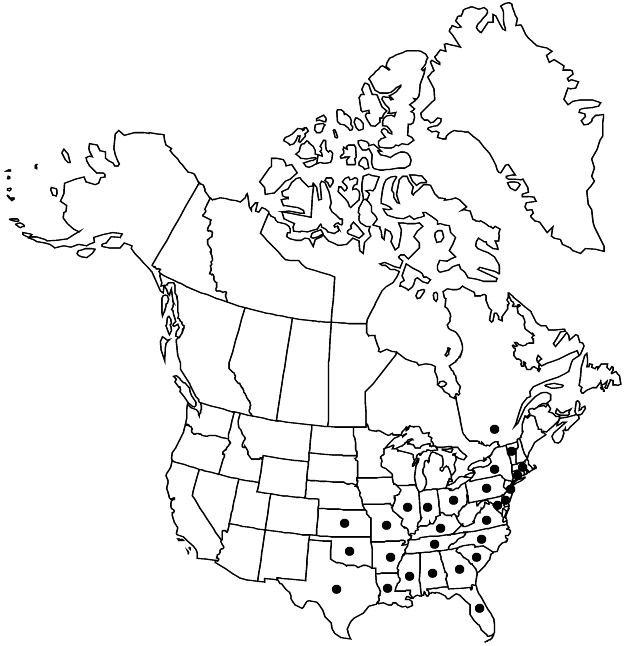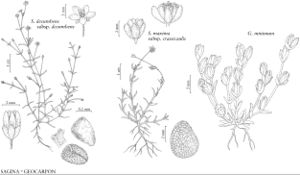Difference between revisions of "Sagina decumbens subsp. decumbens"
FNA>Volume Importer |
FNA>Volume Importer |
||
| Line 23: | Line 23: | ||
|elevation=0-500 m | |elevation=0-500 m | ||
|distribution=Que.;Ala.;Ark.;Conn.;Del.;Fla.;Ga.;Ill.;Ind.;Kans.;Ky.;La.;Md.;Mass.;Miss.;Mo.;N.J.;N.Y.;N.C.;Ohio;Okla.;Pa.;S.C.;Tenn.;Tex.;Vt.;Va. | |distribution=Que.;Ala.;Ark.;Conn.;Del.;Fla.;Ga.;Ill.;Ind.;Kans.;Ky.;La.;Md.;Mass.;Miss.;Mo.;N.J.;N.Y.;N.C.;Ohio;Okla.;Pa.;S.C.;Tenn.;Tex.;Vt.;Va. | ||
| − | |discussion=<p>Specimens of subsp. decumbens from Alberta, New Brunswick, Saskatchewan, and Arizona represent historical collections that apparently did not persist.</p><!-- | + | |discussion=<p>Specimens of <i></i>subsp.<i> decumbens</i> from Alberta, New Brunswick, Saskatchewan, and Arizona represent historical collections that apparently did not persist.</p><!-- |
| − | --><p>Subspecies decumbens is extremely variable. A slender, nearly apetalous variation with a greater frequency of 4-merous flowers has previously been recognized as var. smithii; the range of variability is continuous and it seems best to consider the material as a single taxon.</p> | + | --><p>Subspecies decumbens is extremely variable. A slender, nearly apetalous variation with a greater frequency of 4-merous flowers has previously been recognized as <i></i>var.<i> smithii</i>; the range of variability is continuous and it seems best to consider the material as a single taxon.</p> |
|tables= | |tables= | ||
|references= | |references= | ||
| Line 48: | Line 48: | ||
|publication year= | |publication year= | ||
|special status= | |special status= | ||
| − | |source xml=https://jpend@bitbucket.org/aafc-mbb/fna-data-curation.git/src/ | + | |source xml=https://jpend@bitbucket.org/aafc-mbb/fna-data-curation.git/src/8f726806613d60c220dc4493de13607dd3150896/coarse_grained_fna_xml/V5/V5_297.xml |
|subfamily=Caryophyllaceae subfam. Alsinoideae | |subfamily=Caryophyllaceae subfam. Alsinoideae | ||
|genus=Sagina | |genus=Sagina | ||
Revision as of 17:38, 18 September 2019
Leaves: basal rosette forming in winter annual plants, absent later. Sepals ovate, hyaline margins or apex frequently purple. Seeds light tan, with delicate reticulate ridge pattern (50–80×), smooth or pebbled to strongly tuberculate. 2n = 36.
Phenology: Flowering spring–early summer.
Habitat: Moist or dryish sandy places, field margins, open pine woods, paths, roadsides, sidewalk cracks, lawns
Elevation: 0-500 m
Distribution

Que., Ala., Ark., Conn., Del., Fla., Ga., Ill., Ind., Kans., Ky., La., Md., Mass., Miss., Mo., N.J., N.Y., N.C., Ohio, Okla., Pa., S.C., Tenn., Tex., Vt., Va.
Discussion
Specimens of subsp. decumbens from Alberta, New Brunswick, Saskatchewan, and Arizona represent historical collections that apparently did not persist.
Subspecies decumbens is extremely variable. A slender, nearly apetalous variation with a greater frequency of 4-merous flowers has previously been recognized as var. smithii; the range of variability is continuous and it seems best to consider the material as a single taxon.
Selected References
None.
